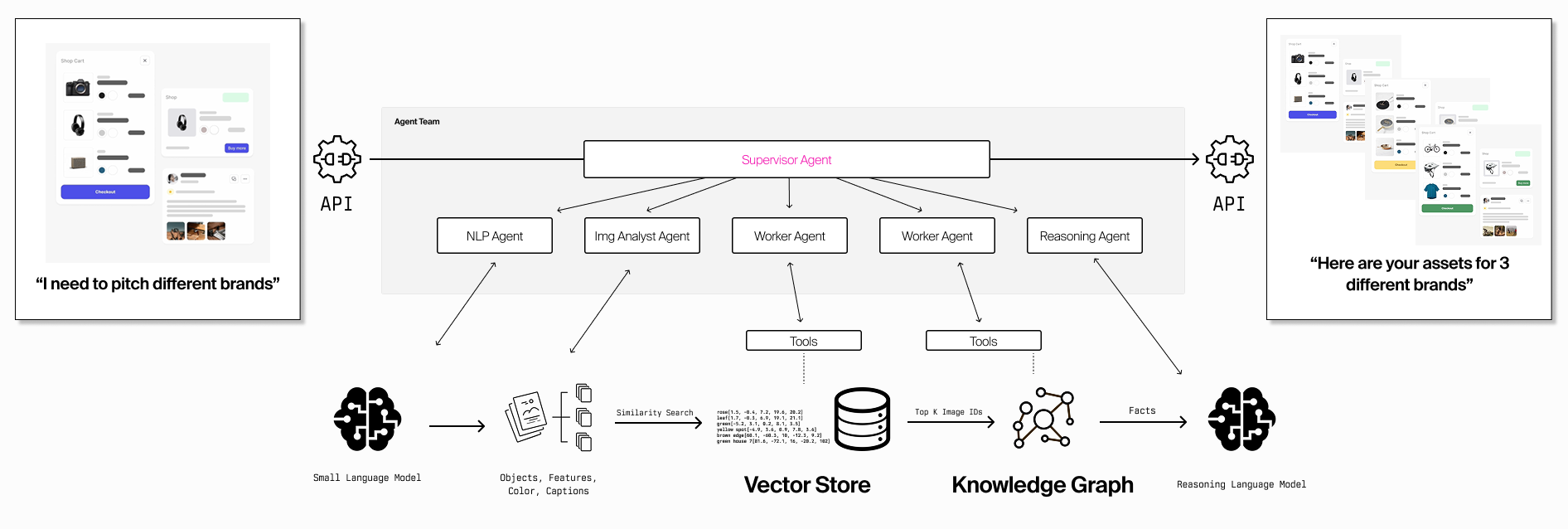APRIL 15 2025
Reimagining personalization with agentic systems
Discover how agentic AI workflows transform ecommerce personalization, pairing human expertise with AI for better conversion rates and efficiency
Personalization is the key for customer engagement. In today’s digital marketing landscape, AI is reshaping how businesses approach personalization, enabling them to analyze vast amounts of data, predict customer preferences, and deliver tailored experiences in real-time.
However, traditional personalization workflows are often manual, time-consuming, and prone to inconsistencies. What if businesses could transform these processes into intelligent, adaptive systems that learn and improve with each interaction?
Enter agentic AI workflows—a new approach that redefines how companies connect with their customers.
Challenges with today’s personalization approaches
Despite advancements in AI and automation, many businesses still rely on traditional, labor-intensive personalization methods.

These conventional approaches face several significant challenges:
- High manual effort: Each stage of personalization—from asset creation to content curation—requires extensive human intervention.
- Lack of context awareness: Traditional workflows often struggle to maintain a deep understanding of user preferences, past interactions, and evolving market trends, leading to generic or ineffective personalization.
- Scalability complexity: As businesses grow and customer touchpoints expand, manually managing personalization efforts across multiple channels becomes unmanageable.
- Inconsistencies in brand messaging: With multiple team members handling various aspects of content creation, ensuring consistency in brand tone, voice, and compliance with guidelines becomes difficult.
- Data silos and integration challenges: Personalization requires access to diverse data sources, but fragmented systems and poor integration strategies can hinder effective data utilization.
- Slow execution, iteration, and optimization: A lack of automated feedback loops means personalization strategies often take longer to refine and improve, leading to missed opportunities for engagement and conversion.
As these businesses scale to new brands and personalized assets, they must both ensure brand consistency across multiple campaigns and navigate complex approval workflows and rapidly generate variations tailored to different audience segments. The manual nature of these processes leads to inefficiencies, missed deadlines, and increased costs.
Leapfrogging from AI-powered to agentic workflows
To transition from existing approaches to agentic flows, teams should adopt a structured framework to systematically and incrementally replace manual tasks with agents and tools. This involves:
- Drawing data maps: Identifying the information that must be known with certainty versus probabilistic insights. This helps determine where AI can be added given its non-deterministic nature.
- Assessing data sources: Mapping out where critical data resides, including CRM systems, behavioral analytics, third-party APIs, and internal content repositories. Integration of these sources and ensuring a robust knowledge foundation allows for a unique and timely response for personalization.
- Identifying research tasks: Understanding which aspects of personalization require extensive research and how AI enhances these tasks. By automating the discovery of insights, AI reduces the time needed for campaign planning and optimization.
- Optimizing data plumbing: Addressing backend data challenges, such as cleansing, normalizing, and structuring information, to ensure high-quality inputs. Standardizing these processes minimizes inconsistencies and enhances AI performance.
These steps set the stage for designing agentic AI workflows and breaking down each workflow into discrete jobs to be done.

Assigning the “jobs to be done”
We can break down the core tasks an agentic AI personalization system should handle:
- Create Asset Request: Intelligent parsing of campaign objectives and translating them into structured requests
- Get Reference Examples: AI-driven research to analyze successful past campaigns to gather relevant inspiration
- Get Brand Identity: Deep understanding of brand voice, style, and visual identity
- Get Related Assets: Contextual asset discovery and recommendation aligned with the brand
- Get Available Templates: Dynamic selection of asset templates relevant to the campaign
- Select Ad Candidates: Predictive modeling to determine high-performing ad variations
- Get Product Metadata: Comprehensive product information integration
- Generate Ad Images: AI-powered visual content creation
- Generate Ad Video: Multimodal content generation
- Assemble Asset: Intelligent composition
- QA Asset: Automated and human-guided qualification verification
Each of these steps involves multi-agent coordination, aligning with Hypermode’s framework for a on structured, adaptable workflows for AI-driven automation.
Rather than advocating for full automation from the outset, a human-in-the-loop, incremental approach ensures precision and trust in AI outputs. This strategy consists of two primary phases:
- AI augmentation: A dashboard allows human experts to:
- Review AI-generated content
- Approve, reject, or refine outputs
- Provide contextual feedback for iterative learning
- Continuous Learning: AI logs human interventions to refine its models and improve over time.
Technical considerations for implementation
Implementing agentic AI workflows requires attention to several technical aspects to ensure efficiency, scalability, and compliance. Key considerations include:
- Context management: Developing a robust system to collect and maintain relevant contextual data is crucial. This involves integrating historical interactions, user preferences, and real-time information to provide AI agents with the necessary context for informed decision-making.
- Agent orchestration: Coordinating multiple AI agents to handle specialized tasks necessitates a flexible framework. Effective orchestration ensures seamless collaboration among agents, optimizing task execution and adapting to dynamic workflows.
- Feedback mechanisms: Implementing structured logging systems allows AI models to learn from human adjustments. Continuous feedback loops enable the system to refine its outputs over time, enhancing personalization accuracy.
- Privacy and compliance: Ensuring secure data handling is paramount. This involves implementing anonymization protocols and adhering to governance measures to comply with data protection regulations and maintain user trust.

The future of personalization
Agentic systems represent more than a technical upgrade—they're a strategic transformation. By treating agents as a collaborative partner rather than a replacement, businesses can unlock unprecedented levels of personalization and efficiency.
- Audit your current personalization workflows
- Identify repetitive, context-dependent tasks
- Start with a pilot project using human-in-the-loop augmentation
- Invest in robust context management and agent design
- Continuously learn and iterate
The future is not about replacing humans—it’s about empowering them with intelligent, adaptive systems that understand context, learn continuously, and deliver extraordinary results.
Are you ready to reimagine personalization? Build your agent today.